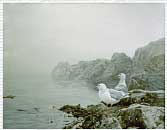The problem with reporters is that sometimes you get like that -- excited by bad news.
My friend said, "good news doesn't do it?"
No. Some of it is adrenaline and excitement -- but there's a good side to that -- when you find a story that hasn't been covered -- break a piece of really bad news -- the potential for you to do good as a reporter is much, much higher. To draw light to -- understanding -- improvement.
Good news stories only make people feel good.
Sometimes you just want to feel good.

Photograph by Ralph Lee Hopkins
National Geographic
David Llewellyn, MP
Minister for Primary Industries and Water
Wednesday, 9 April 2008
Oil Spill Survivor Outlives Average Life Expectancy
A Little penguin rescued during the Iron Baron oil spill incident over a decade ago, has gone on to live for more than double the average life expectancy for the species, Primary Industries and Water Minister David Llewellyn said today.
Mr Llewellyn said although the Little penguin died earlier this year, its survival for almost 13 years after the major oil spill highlighted the value of the rehabilitation effort following the oil spill.
Mr Llewellyn said earlier this year local school students retrieved the band fitted to the penguin which enabled Department of Primary Industries and Water wildlife staff to trace the penguin’s history.
“It should be incredibly satisfying for everyone who played a part in the rehabilitation effort after the oil spill to know of the longevity of some of the species that they assisted,” Mr Llewellyn said.
“The details from the band and DPIW records show that this Little penguin was one that was covered in oil when it was brought in as an 800 gram adult male.
“Following cleaning and rehabilitation he was released on July 26 1995 at Low Head weighing 960 grams.
“In the following 12 and a half years he appears to have remained in the local area with his body being found only seven kilometres from where he was released,” Mr Llewellyn said.
DPIW Wildlife and Marine Conservation Section Head Rosemary Gales said the Little penguin was already an adult when it was rescued and so was certainly older than 13 when it died.
“On average in the wild Little penguins are estimated to live about 6.5 years, so this one has certainly far exceeded the average life expectancy for the species,” Mr Llewellyn said.
“It is an incredibly valuable record to get as it highlights that the massive wildlife rehabilitation efforts that are put in after oil spills can certainly be effective in reducing the impacts of a spill.”
Rehabilitation Manager at the oil spill site Mark Holdsworth said over 100 volunteers assisted the efforts to clean, feed and house around 2000 Little penguins at the time.
“The survival of this penguin for so long will be greeted with a sense of pride from our team of penguin carers,” Mr Holdsworth said.
“This also provides us with a sense of confidence that if an unfortunate accident like this were to occur again, we can do something positive to help restore an important part of the environment.”
Dr Gales said research undertaken, after the oil spill at the mouth of the Tamar River on July 10 1995, estimated that between 10,000 and 20,000 penguins were killed as a result of the oil spill.
“Unless treated, even small amounts of oil on the plumage of seabirds can result in their death – either through drowning, hypothermia or acute toxicity,” Dr Gales said.
“Rehabilitation of oiled seabirds can reverse the immediate physical effects of oiling.
“However the discovery of this little penguin has highlighted the real value of these rehabilitation efforts by showing how long they can continue to survive if they are given the opportunity,” Dr Gales said.



















